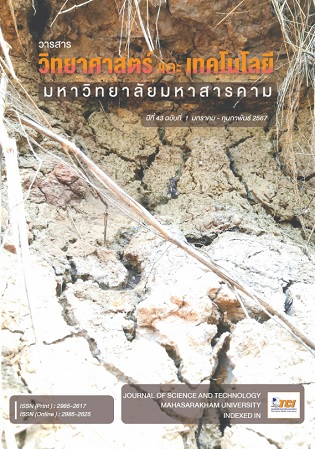Thermodynamics model of a freezing process in tube ice production
Main Article Content
Abstract
This research article proposes a thermodynamics model of a freezing process in tube ice-making machines to determine process time and cooling load throughout the freezing process. Nowadays, production of tube ice to the required thickness, a tube ice-making machine will set the freezing process time to be constant in every production cycle under only one feed water temperature. However, the actual thickness of the tube ice produced was not as required because the feed water temperature deviated by two factors: the ambient temperature and the reduction in the feed water temperature at the heat exchanger using the chilled water from the defrost process of production cycle ago for energy saving. In the past, the cooling load calculation throughout the freezing process with a mathematical model based on Newton's law of cooling without consideration of the feed water temperature and the decreased water temperature in the freezer tower. The results of this research article revealed that the process's time from the simulation is close to the actual working time of the freezing process in the tube ice-making machine. The maximum cooling load occurs at the initial time and decreases speedily in the early period and slower in the latter period because of the difference in temperature between the water temperature and the refrigerant saturated temperature and the thermal resistance of tube ice from increasing thickness. This cooling load has known the evaporation rate of the refrigerant throughout the freezing process, which is the main result that guides the determination of the refrigerant suction rate of a compressor suitable for the tube ice-making machine.
Article Details
References
ณัฐดนย์ พรรณุเจริญวงษ์, ฉัตรชัย เบญจปิยะพร, รพีพัฒน์ ลาดศรีทา, & สุกัญญา ทองโยธี. (2556). การศึกษาพารามิเตอร์ที่มีผลต่อการแข็งตัวของน้ำแข็งหลอด. The Journal of Industrial Technology, 9(3), 63-80.
ธีรวัฒน์ คลับคล้าย, & ธีระชาติ พรพิบูลย์. (2556). แบบจำลองทางเทอร์โมไดนามิกส์ของกระบวนการต้มและอุ่นนํ้าอ้อยแบบหลายขั้นตอนในกระบวนการผลิตนํ้าตาล. วารสารวิทยาศาสตร์และเทคโนโลยี มหาวิทยาลัยมหาสารคาม, 32(5), 606-616.
ภูวนาถ กาบคำ. (2547). การศึกษาเพื่อปรับปรุงประสิทธิภาพการผลิตน้ำแข็งหลอด. [วิทยานิพนธ์ปริญญามหาบัณฑิต, จุฬาลงกรณ์มหาวิทยาลัย]. Chulalongkorn University Intellectual Repository (CUIR). http://cuir.car.chula.ac.th/handle/123456789/1515
Ozisik, M. N. (1985). Heat transfer: A basic approach. McGraw-Hill.
Pannucharoenwong, N., Benjapiyaporn, C. Theerakulpisut, S., Saeng-Uthai, S., Benjapiyaporn, J. & Promteerawong, P. (2016). 50 Ton tubular ice factory production optimization. Engineering and Applied Science Research, 43, 180-182.
Stephan, K., & Abdelsalam, M. (1980). Heat-transfer correlations for natural convection boiling. International Journal of Heat and Mass Transfer, 23(1), 73-87.
Stoecker, W. F. (1989). Design of thermal systems (3rd ed.). McGraw-Hill.
Stoecker, W. F., & Jones, J. W. (1982). Refrigeration and air conditioning. McGraw-Hill.
Tangthieng, C. (2011). Effect of tube diameter on the specific energy consumption of the ice making process. Applied Thermal Engineering, 31(5), 701-707.
Thongdee, A. & Chinsuwan A. (2019). An optimization of the components and operating conditions of a pre-cooling system for tubular ice making machines. Energy Procedia, 157, 602-610.


